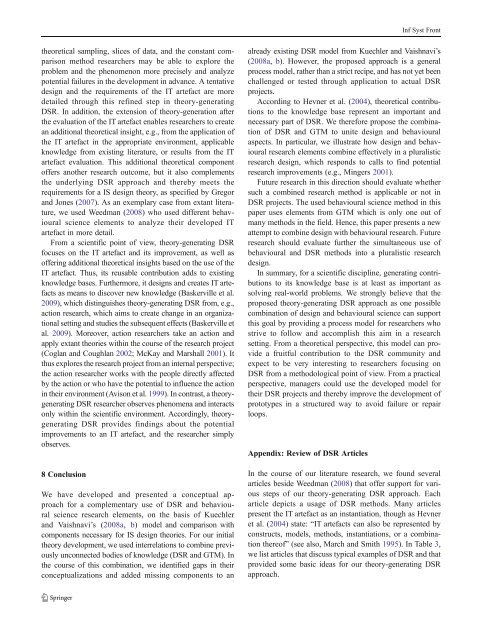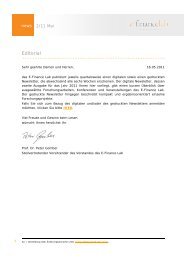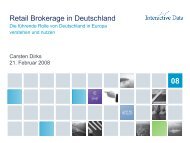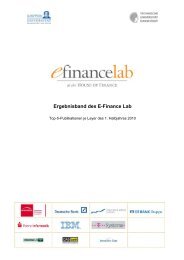Prof. Dr. Wolfgang König, Prof. Dr.-Ing. Ralf ... - E-Finance Lab
Prof. Dr. Wolfgang König, Prof. Dr.-Ing. Ralf ... - E-Finance Lab
Prof. Dr. Wolfgang König, Prof. Dr.-Ing. Ralf ... - E-Finance Lab
You also want an ePaper? Increase the reach of your titles
YUMPU automatically turns print PDFs into web optimized ePapers that Google loves.
theoretical sampling, slices of data, and the constant comparison<br />
method researchers may be able to explore the<br />
problem and the phenomenon more precisely and analyze<br />
potential failures in the development in advance. A tentative<br />
design and the requirements of the IT artefact are more<br />
detailed through this refined step in theory-generating<br />
DSR. In addition, the extension of theory-generation after<br />
the evaluation of the IT artefact enables researchers to create<br />
an additional theoretical insight, e.g., from the application of<br />
the IT artefact in the appropriate environment, applicable<br />
knowledge from existing literature, or results from the IT<br />
artefact evaluation. This additional theoretical component<br />
offers another research outcome, but it also complements<br />
the underlying DSR approach and thereby meets the<br />
requirements for a IS design theory, as specified by Gregor<br />
and Jones (2007). As an exemplary case from extant literature,<br />
we used Weedman (2008) who used different behavioural<br />
science elements to analyze their developed IT<br />
artefact in more detail.<br />
From a scientific point of view, theory-generating DSR<br />
focuses on the IT artefact and its improvement, as well as<br />
offering additional theoretical insights based on the use of the<br />
IT artefact. Thus, its reusable contribution adds to existing<br />
knowledge bases. Furthermore, it designs and creates IT artefacts<br />
as means to discover new knowledge (Baskerville et al.<br />
2009), which distinguishes theory-generating DSR from, e.g.,<br />
action research, which aims to create change in an organizational<br />
setting and studies the subsequent effects (Baskerville et<br />
al. 2009). Moreover, action researchers take an action and<br />
apply extant theories within the course of the research project<br />
(Coglan and Coughlan 2002; McKay and Marshall 2001). It<br />
thus explores the research project from an internal perspective;<br />
the action researcher works with the people directly affected<br />
by the action or who have the potential to influence the action<br />
in their environment (Avison et al. 1999). In contrast, a theorygenerating<br />
DSR researcher observes phenomena and interacts<br />
only within the scientific environment. Accordingly, theorygenerating<br />
DSR provides findings about the potential<br />
improvements to an IT artefact, and the researcher simply<br />
observes.<br />
8 Conclusion<br />
We have developed and presented a conceptual approach<br />
for a complementary use of DSR and behavioural<br />
science research elements, on the basis of Kuechler<br />
and Vaishnavi’s (2008a, b) model and comparison with<br />
components necessary for IS design theories. For our initial<br />
theory development, we used interrelations to combine previously<br />
unconnected bodies of knowledge (DSR and GTM). In<br />
the course of this combination, we identified gaps in their<br />
conceptualizations and added missing components to an<br />
already existing DSR model from Kuechler and Vaishnavi’s<br />
(2008a, b). However, the proposed approach is a general<br />
process model, rather than a strict recipe, and has not yet been<br />
challenged or tested through application to actual DSR<br />
projects.<br />
According to Hevner et al. (2004), theoretical contributions<br />
to the knowledge base represent an important and<br />
necessary part of DSR. We therefore propose the combination<br />
of DSR and GTM to unite design and behavioural<br />
aspects. In particular, we illustrate how design and behavioural<br />
research elements combine effectively in a pluralistic<br />
research design, which responds to calls to find potential<br />
research improvements (e.g., Mingers 2001).<br />
Future research in this direction should evaluate whether<br />
such a combined research method is applicable or not in<br />
DSR projects. The used behavioural science method in this<br />
paper uses elements from GTM which is only one out of<br />
many methods in the field. Hence, this paper presents a new<br />
attempt to combine design with behavioural research. Future<br />
research should evaluate further the simultaneous use of<br />
behavioural and DSR methods into a pluralistic research<br />
design.<br />
In summary, for a scientific discipline, generating contributions<br />
to its knowledge base is at least as important as<br />
solving real-world problems. We strongly believe that the<br />
proposed theory-generating DSR approach as one possible<br />
combination of design and behavioural science can support<br />
this goal by providing a process model for researchers who<br />
strive to follow and accomplish this aim in a research<br />
setting. From a theoretical perspective, this model can provide<br />
a fruitful contribution to the DSR community and<br />
expect to be very interesting to researchers focusing on<br />
DSR from a methodological point of view. From a practical<br />
perspective, managers could use the developed model for<br />
their DSR projects and thereby improve the development of<br />
prototypes in a structured way to avoid failure or repair<br />
loops.<br />
Appendix: Review of DSR Articles<br />
Inf Syst Front<br />
In the course of our literature research, we found several<br />
articles beside Weedman (2008) that offer support for various<br />
steps of our theory-generating DSR approach. Each<br />
article depicts a usage of DSR methods. Many articles<br />
present the IT artefact as an instantiation, though as Hevner<br />
et al. (2004) state: “IT artefacts can also be represented by<br />
constructs, models, methods, instantiations, or a combination<br />
thereof” (see also, March and Smith 1995). In Table 3,<br />
we list articles that discuss typical examples of DSR and that<br />
provided some basic ideas for our theory-generating DSR<br />
approach.








